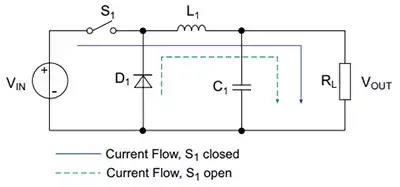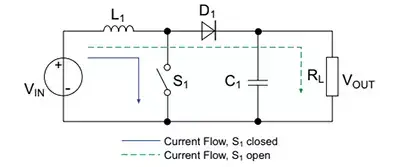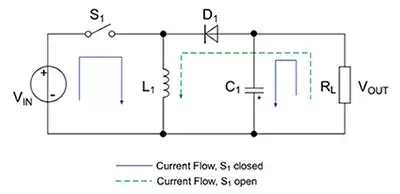

Buck vs Boost Converter: A Comparison
Catalog
Buck vs Boost ConverterWhat is a Buck Converter?What is a Boost Converter?What is a Buck-Boost Converter?Buck vs Boost Converter: How Does It Work?Buck vs Boost Converter: DifferencesKey Applications: Buck vs Boost ConverterFrequently Asked QuestionsFinal VerdictRelated ArticlesBuck vs Boost Converter
The output voltage and current of both buck and boost converters are different from the input voltage and current. There are two main types of topologies: inverting and non-inverting converters. When the output voltage is inverted, the polarity of the output is the opposite of the input voltage. On the other hand, with a non-inverting converter, the output voltage has the same polarity as the input.
An inductor acts like a voltage storage device. It helps regulate the input voltage by switching a MOSFET and storing energy.

Buck vs Boost Converter
What is a Buck Converter?
A buck converter, also known as a step-down converter, is a type of DC/DC switch-mode power supply. It’s designed to lower the input voltage from an unregulated DC source to a more stable, lower output voltage. One of the main reasons buck converters are so popular is their high efficiency, often over 95%, which is much better than traditional voltage regulators. The simplified circuit diagram shows how the current flows during the switching process of a buck converter.
Buck converters are commonly used instead of older, less efficient linear regulators to provide low-voltage power on board for things like microprocessors, communication equipment, control systems, and many other applications.

What is a Boost Converter?
A boost converter is a DC/DC switch-mode power supply that increases the input voltage from an unregulated DC source to a higher, stabilized output voltage. Like a buck converter, a boost converter uses components like an inductor, diode, capacitor, and power switch to regulate the output voltage. However, these components are arranged differently in the circuit. The simplified diagram shows how the current flows during a switching event in a boost converter.
In a boost converter, the output voltage is controlled by the mark-space ratio of the PWM signal, which adjusts it to be equal to or greater than the input voltage. Since power is conserved, a boost converter that triples the input voltage can only supply one-third of the current it pulls from the supply. Boost converters are especially common in battery-powered devices. For example, two 3V batteries might be used to power a circuit that needs 5V.

What is a Buck-Boost Converter?
A buck-boost converter is a type of power supply that can provide a regulated DC output, even if the input voltage is either below or above the desired output voltage. It combines elements of both a buck converter and a boost converter, though it tends to have a larger footprint than either of the two. The simplified diagram shows how current typically flows through the circuit during a switching event in a buck-boost converter.
If you look closely at the circuit diagram, you’ll notice that the output voltage (V out) is actually negative compared to the supply voltage. This can make certain designs a bit more complicated. Buck-boost converters also require more expensive components since they need to handle both high input voltage and high input current at different points. Despite these challenges, they’re really useful in a lot of applications. A common example is high-power LED lighting, where a buck-boost converter is used to supply a steady 12V output from lead-acid batteries, which may supply anywhere from 9V to 14V.

Buck vs Boost Converter: How Does It Work?
Keep reading to learn how both buck and boost converters work in real life. In this section, we’ll break it down for you. Let’s dive in!
Buck Converter
A buck converter steps down DC voltages to lower DC voltages of the same polarity, and it’s one of the most common types of switching converters. For example, if you need to convert 24V to 15V, 12V, or 5V with minimal power loss, a buck converter is key in systems with distributed power rails (like 24V to 48V systems).
In a buck converter, the input voltage is forced across an inductor, which causes it to store energy as a charge. While the load and output capacitor charge up, the current flows into both. When the switch is off, the inductor and capacitor currents combine to supply the total current to the load.
Boost Converter
Boost converters, on the other hand, take a DC input voltage and step it up to a higher DC voltage of the same polarity. When the voltage is forced across the inductor, the current gradually increases, and the switch controls this. When the switch turns off, the diode becomes forward biased, and the capacitor charges up to a voltage higher than the input voltage, thanks to the decreasing inductor current.
When the switch is off, both the output capacitor and load get their current from the inductor. During the operation of the switch, the capacitor is the only source of current for the load.
Buck vs Boost Converter: Differences
Curious about the differences between buck and boost converters? If so, check out this section for the details!
Even though buck and boost converters work in similar ways and serve similar purposes, they do have some key differences:
Boost Converter
- Voltage Increase: Boost converters are used to convert an input voltage to a higher output voltage.
- Switching Operation: Just like buck converters, boost converters flow current through a transistor with the help of an inductor. The inductor stores energy when it’s on and transfers that energy to the output when it’s off.
- Applications: Boost converters are used when you need a higher output voltage than the input. They’re commonly found in things like batteries, solar panels, and LED drivers.
Buck Converter
- Voltage Reduction: Buck converters, also known as step-down converters, lower the output voltage to a level that’s below the input.
- Switching Operation: In a buck converter, the current flow through an inductor is controlled by turning a transistor on and off. The inductor stores energy when it’s on and passes that energy to the output when it’s off.
- Applications: Buck converters are used when you need a lower output voltage than the input, like in battery-powered devices and voltage regulators.
Key Differences
- Functionality: Buck converters lower the voltage, while boost converters raise it.
- Output Voltage: Boost converters can provide a voltage higher than the input, while buck converters can only provide a voltage lower than the input.
- Applications: Use a buck converter when you need to step down voltage and a boost converter when you need to step up voltage.
Converters in power electronics mainly fall into two categories: buck and boost. Each has its own purpose based on the voltage requirements, so knowing the differences will help you choose the right one for your needs.
Key Applications: Buck vs Boost Converter
Buck Converter
- Battery-Powered Devices: Mobile phones, laptops, and other battery-powered gadgets often use buck converters. They help prevent batteries from overheating and extend battery life by stepping down the battery voltage.
- Voltage Regulation: Buck converters are great at keeping the output voltage stable, even when the input voltage fluctuates or the load changes. They’re perfect for applications like voltage regulators, power supplies, and automotive electronics where you need consistent performance.
- LED Lighting: In LED lighting systems, buck converters regulate the voltage supplied to the LEDs. They help control the brightness efficiently while minimizing power loss by stepping down the voltage from the power source.
Boost Converter
- LED Drivers: Boost converters are commonly used in LED driver circuits, especially when LEDs need higher voltages than what the power source can provide. Boost converters make sure LED lighting systems work reliably and efficiently by increasing the input voltage to match the LEDs’ needs.
- Battery Charging: Boost converters are often used in battery charging circuits, particularly when the circuit needs a higher voltage than the input source can supply. For example, a solar-powered or portable charger might need a boost converter if the input voltage is lower than the battery voltage.
- Wireless Communication: Boost converters are essential in radio frequency (RF) transmitters and receivers, which need higher voltages to transmit and receive signals effectively. They boost the input voltage to help extend the range and reliability of wireless communication links.
Frequently Asked Questions
Question 1: Where are buck converters commonly used?
Answer: Buck converters are commonly used when the output voltage needs to be lower than or equal to the input voltage. They’re found in battery-powered devices, voltage regulators, and electronics that need efficient power conversion.
Question 2: What are typical applications of boost converters?
Answer: Boost converters are used when you need an output voltage higher than the input voltage. Common applications include low-voltage systems like battery chargers, solar panels, LED drivers, and more.
Question 3: Can buck and boost converters be combined in a single circuit?
Answer: Yes! Buck-boost converters can do both: step up and step down voltage. They can adjust output voltages or provide multiple outputs when the input voltage fluctuates.
Question 4: Are buck and boost converters efficient?
Answer: Both buck and boost converters can be very efficient when used correctly within their designed parameters. Efficiency depends on factors like load conditions, component choices, and the overall circuit design.
Final Verdict
Ultimately, whether you need a buck converter or a boost converter depends on your application’s voltage needs. Buck converters are perfect for devices that need to step down voltage efficiently, like battery-powered electronics or systems that require stable voltage regulation. They’re great at reducing voltage and optimizing battery use.
On the other hand, if you need to increase voltage, like in an LED driver, charger circuit, or wireless communication system, a boost converter is the way to go. Understanding the functions and applications of each type can help you achieve the best performance and efficiency for your electronic designs.
Want to check out more electronics parts? Visit JMBom ELECTRONICS and order your components in just a few steps!
Related Articles
Analog to Digital Converter:Everything You Need to Know
Introduction to DC to AC Converter
Introduction to CR1616 Battery Equivalent
A Complete Guide to Reed Switches
A Complete Guide to Integrated Amplifier
Microprocessor vs. Integrated Circuit:Which is Best?
Introduction to CR1616 Battery Equivalent
CR1616 Battery Equivalent:What You Need to Know
Subscribe to JMBom Electronics !













